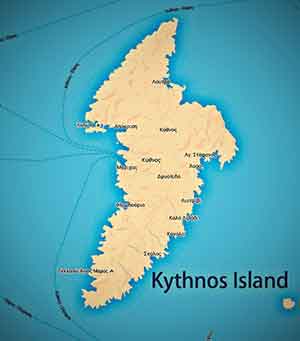Agia Irini (Saint Irene) is located in the northeast of the island very close to the popular Loutra (Baths) is just 6 km from the town (Hora) and 1.5 km from the Loutra. It is perhaps the most picturesque coastal settlement on the island with characteristic whitewashed Cycladic houses with colored doors and windows beside the sea.
The small chapel of Agia Irini located on the edge of the sheltered harbor, the few picturesque houses, fishing boats and boats tied up at the pier and off shore make a serene cinematic backdrop.
On the sandy beach of the village, the visitor can enjoy the blue waters. On the small waterfront is the old cafe of the village renovated and transformed into a great restaurant where the traveler has the opportunity to taste authentic dishes with ingredients sourced from local vegetable gardens and exquisite seafood. Even organized receptions are hosted at the site, as many celebrities and ordinary visitors choose the church of St. Irene for holding religious rites.
In seaside chapel of Saint Irene are three marble plaques in memory of the "Kythniaka" (an armed rescue effort) that took place in March 1862. In the modern history of Greece after the suppression of the revolution and unrest in Nafplio in January 1862 and according to the practices of king Otto, the imprisonment of the ringleaders followed on Kythnos. Then the lieutenant Nicholas Maniatis Leotsakos commander of the military garisson of Syros, sought their release. He with the help of lieutenant Pericles Moraitini and 30 other soldiers captured the steamer "Karteria" headed to Kythnos, but the government steamship (atmodromon) "Amalia" engaged the "Karteria” leading them to seek resort in the port of St. Irene. Leotsakos headed to the capital, releasing the prisoners. Due to the lack of organization, he was ultimately left with only about 15 soldiers and a few civilians to face overwhelming government forces on a hill near the Loutra (Baths) resulting in the deaths of himself, the lieutenant Moraitinis, the student Agamemnon Skarvelis two rebels and three civilians. The governmental Capt Tsiros committed hubris leaving their bodies unburied. The people commemorate the fallen with folk songs and poems. After the eviction of Otto, a memorial to the fallen was held in Athens and plaques with their names were placed in the chapel of Saint Irene.
The whole area especially north of Loutra has been excavated as prehistoric remains have been found belonging to the settlements of the Mesolithic Age (9th-8th millennium BC).
Behind the village, visitors can cool off at the stone built water spring. It is said that in the past in the area, behind the church, there were waters gushing from a spring and many went with their mules to provide drinking water for their homes. The chapel of St. Nicholas with the secluded beach is also noteworthy.
join.booking.com


























